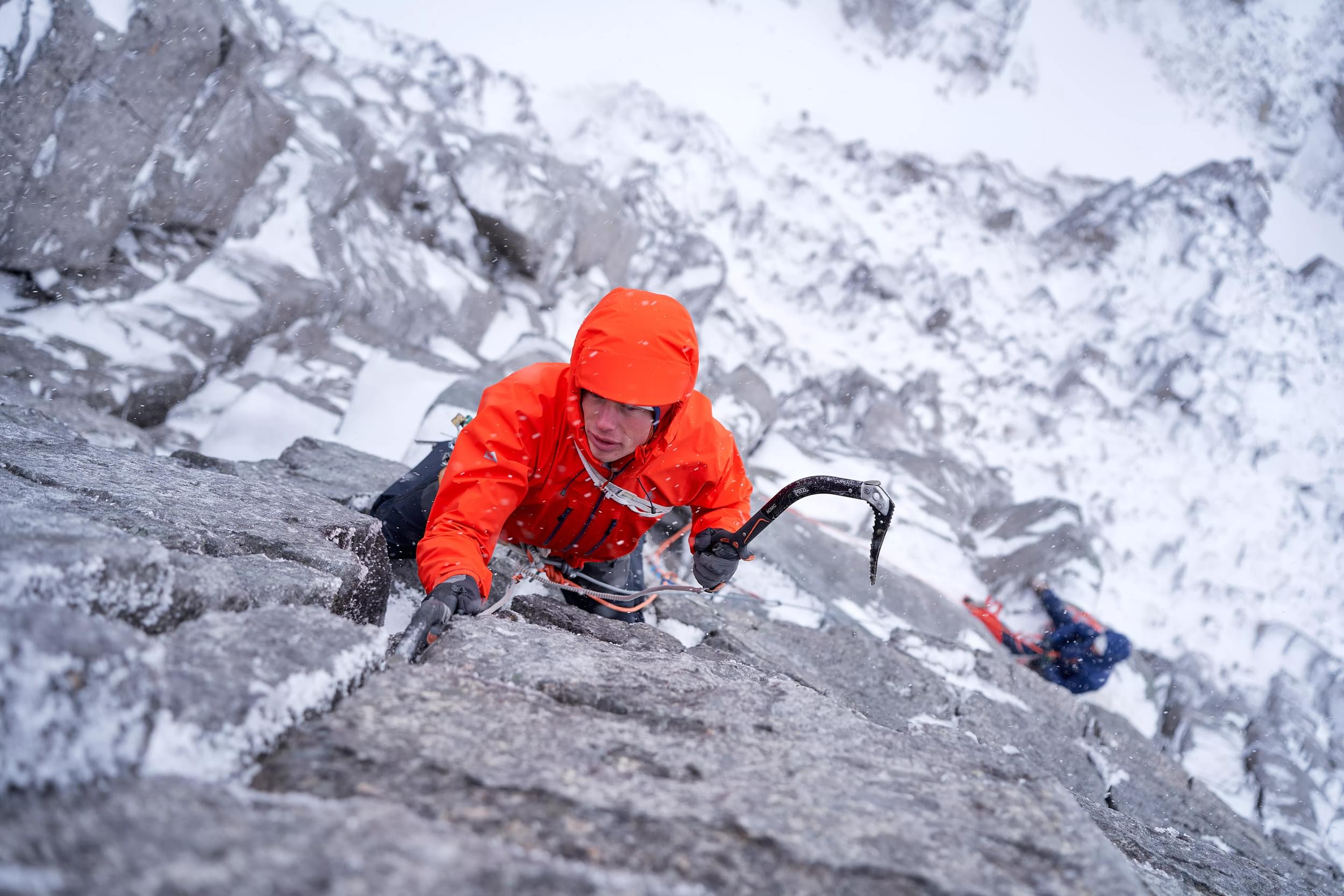General Care
Our waterproof clothing is built to last but will last longer and perform better if cared for correctly. Waterproof clothing should be periodically washed and after use should be dried thoroughly. When not in use it should be stored in a cool dry place away from direct sunlight. Zips should be kept clean and regularly lubed. The advice on this page is intended for garments we describe as waterproof i.e. GORE-TEX PRO, GORE-TEX or DRILITE® garments only. It is not intended for water resistant garments.

How to Wash Your Waterproof
Grease and dirt from body sweat, mud or even sun-cream can all impede the breathability and overall waterproof performance of your waterproof clothing, making you feel damp and cold, even if the clothing isn’t actually leaking.
With the exception of insulated waterproof garments the cleaning method for all of our waterproof garments is the same. They should ideally be washed using a specialist cleaning product such as Grangers Performance Wash, Nikwax Tech Wash,Fibertec Pro Wash, or Storm Clothing Wash. If these aren’t available then soap flakes which can be purchased from a supermarket are also fine. If your garment is extremely dirty then simple liquid detergent without fabric softeners can be used as a last resort, but only if other methods have not managed to clean your garment. Do not under any circumstances use fabric conditioner: it will likely ruin the fabric’s DWR and may cause lasting damage to the construction of the product.
Before you begin, clean any detergent out of your washing machine: if you use the powder drawer, give it a thorough clean, pouring hot water down it to remove any residue. Finally, run a short rinse cycle with the machine empty to clear any remaining detergent.
Ensure all pockets are empty, drawcords under tension are released, velcro adjusters fastened and all zips including pocket zips and ventilation zips are done up fully.
Read the care label found inside the jacket.
Select the appropriate wash cycle on your machine - ideally this should be a programme with a low to medium spin speed setting such as Delicates, Woollens or Handwash and with a temperature setting of 30°C or 40°C. Multiple garments can be washed at once but avoid washing heavily soiled garments together. Rinse extremely thoroughly (at least twice) before removing.
Garments can then be air-dried or tumble-dried as necessary (please check care label) or you can reproof a wet garment. Even if air-dried, tumble-dry again on a low heat setting to help reactivate any DWR (Durable Water Repellency) treatment on the outer fabric. This can also be achieved by carefully ironing the outer fabric on a warm setting, ensuring to place a thin cloth between the garment and the iron. Do not allow the iron to come into contact with any zips, gaskets or logos.
Finally all components such as cordlocks should be checked and zips thoroughly lubed. We recommend using a product such as Gear Aid Zipper Lubricant, McNETT Zip Care or Zipper Stick. Alternatively natural products such as Beeswax can also be used. The garment can then be stored away as normal.
-
How to Wash an Insulated Waterproof Jacket
If you do not have immediate access to a tumble dryer, please do not attempt to wash an insulated waterproof garment yourself. The following advice assumes access to a tumble dryer.
The garment should ideally be washed using a specialist cleaning product such asGrangers Performance Wash,Nikwax Tech Wash,Fibertec Pro Wash, orStorm Clothing Wash. If these aren’t available then soap flakes which can be purchased from a supermarket are also fine. If your garment is extremely dirty then simple liquid detergent without fabric softeners can be used as a last resort, but only if other methods have not managed to clean your garment. Do not under any circumstances use fabric conditioner: it will likely ruin the fabric’s DWR and may cause lasting damage to the construction of the product.
Before you begin, clean any detergent out of your washing machine: if you use the powder drawer, give it a thorough clean, pouring hot water down it to remove any residue. Finally, run a short rinse cycle with the machine empty to clear any remaining detergent.
Ensure all pockets are empty, drawcords under tension are released, velcro adjusters fastened, and all zips including pocket zips and ventilation zips are done up fully.
Read the care label. Take note of the filling type (down or polyester).
Select the appropriate wash cycle on your machine - ideally this should be a programme with a low to medium spin speed setting such as Delicates, Woollens or Handwash and with a temperature setting of 30°C or 40°C . Avoid washing multiple garments at once. Rinse extremely thoroughly (at least twice).
When removing your garment from the machine, do so carefully, as the extra weight of any wet filling could damage internal stitching. If your insulated waterproof clothing is down-filled, the garment may well look flat, empty and / or lumpy. At this stage don’t worry. Your garment now needs to be dried extremely thoroughly. This should be done slowly, using a tumble dryer set to the lowest heat setting available. Selecting a higher temperature in the hope of drying more quickly could easily damage the fabrics and components of your garment.
If your waterproof jacket is down filled (and not synthetic / polyester), the drying process may take several hours, particularly for heavier items of clothing. During this time, periodically check the garment (remove from the tumble dryer) to ensure that it is not getting too hot. If your garment is down filled we also recommend massaging the filling between your hands at frequent intervals. It is important to start this process before the garment becomes too dry; doing so will help to tease apart any clumps and ensure that it regains its natural loft. This process can be aided by adding a couple of tennis balls or other small but firm items to the drum whilst drying.
Tumble-drying will at the same time help to reactivate any DWR (Durable Water Repellency) treatment on the outer fabric. This can also be achieved by carefully ironing the outer fabric on a warm setting, ensuring to place a thin cloth between the garment and the iron. Do not allow the iron to come into contact with any zips, gaskets or logos.
Finally all components such as cordlocks should be checked and zips thoroughly lubed. We recommend using a product such asGear Aid Zipper Lubricant,McNETT Zip Careor Zipper Stick. Alternatively natural products such as Beeswax can also be used. The garment can then be stored away as normal.
Reproofing
A Durable Water Repellent (DWR) treatment on the outer fabric of your waterproof garment helps water to bead and run-off. It is an important component of your jacket's overall waterproof performance.
In use, you will notice the garment gradually begins to ‘wet-out’. This occurs when water is no longer beading and running off the surface but instead is being absorbed into the garment's outer layer of fabric. It is usually most noticeable in high-wear areas such as the shoulders, knees, seat and around the waist. This is because the performance of any DWR is compromised by abrasion as well as dirt and oil contamination. Whilst this will not cause your jacket to leak, it can significantly reduce breathability leading to dampness.
DWR can be reactivated by washing and drying (see washing a waterproof jacket) but if this has not had the desired effect it may be time to consider reproofing your garment as well. Reproofing is a process that should only be undertaken on clean garment.
We recommend using a spray-on reproofer such as Grangers Performance Repel, Grangers Performance Repel, or Nikwax TX Direct Spray-On, Storm Proofer, Storm Eco Proofer, Fibertec Guard Proof or Fibertec Guard Eco.
Concentrate the spray on areas that are ‘wetting out’, following any relevant instructions. If you prefer to use a wash-in reproofer, select the appropriate wash cycle on your machine - ideally this should be a programme with a low to medium spin speed setting such as Delicates, Woollens or Handwash and with a temperature setting of 30°C or 40°C- and add the recommended quantity of proofing agent.
Even if the reproofing product is not heat-activated we still recommend drying the garment in a tumble dryer or ironing the garment as per our washing instructions as the original factory DWR is heat activated.
* Do NOT attempt to apply any re-proofing product to GORE-TEX ShakeDry products.
Field Repairs
Unfortunately, even when well cared for, waterproof garments can get snagged, torn or damaged, especially if climbing or mountaineering. Such damage is not covered by our warranty as this is deemed normal, if unfortunate, wear and tear. However, many of these faults can be repaired both ‘in the field’ and professionally.
Unfortunately, even when well cared for, waterproof garments can get snagged, torn or damaged, especially if climbing or mountaineering. Such damage is not covered by our warranty as this is deemed normal, if unfortunate, wear and tear. However, many of these faults can be repaired both ‘in the field’ and professionally.
-
Small Tears - Gaffa Tape / Duct Tape
Gaffa Tape or Duct tape applied over the immediate tear will work effectively for short-term fixes of waterproof clothing. It is best applied to the inside of the garment but can also be applied to the outer fabric. Either way the fabric needs to be clean and dry. It’s unlikely to be a permanent solution.
-
Small to Medium Sized Tears - Tenacious Tape™ or Betrafol® Tape
Specialist repair tapes such as Tenacious Tape™ or Betrafol® Tape can be very effective at repairing small tears, but they do have a somewhat distinctive aesthetic. Please be aware however that such tapes, whilst extremely durable and often able to endure sustained use even at very low temperatures can leave residual marks which when taken off are near impossible to remove.
-
Jammed or stiff Zip Pulls
Prevention is the best form of cure so regularly clean all zips using warm, soapy water. Do not force jammed zips. If washing and lubing a zip does not free a zip, carefully inspect the zip head for obvious signs of grit or dirt. If tooth or coil damage is visible then the zip puller has already had too much force exerted on it. Only a professional repair can solve this.
Professional Repair
Should you require a professional repair, many of the common problems which occur through use can be rectified and will ensure your waterproof clothing continues to provide many more years of service. This includes partially or completely replacing zips, replacing or re-attaching drawcords, repairing any fabric tears or nicks and re-applying seam tape. Contact us for further information.

End of Life
The lifespan of waterproof clothing varies considerably. Frequency of use, activity type and obviously the durability of the original product will all play a part in how long waterproof clothing can be expected to last for. But if you think your clothing is nearing the end of its life please do everything you can to prolong it. Wear it until it falls apart. Manufacturing waterproof garments which are complex and involve many components and materials is very energy intensive and one of the most effective ways of reducing their environmental impact is, as strange as it may seem for us to say, to make what you buy last as long as possible and not replace it needlessly.
Here’s what you can do instead:
1) Revere it - Our products are made to be used. Learn to value the experience etched into the very fabric of your gear. Every nick, every mark is not just wear & tear but a story and a statement.
2) Revitalise it - Wash and reproof your garments. You can do this yourself or use the services of a professional aftercare service.
3) Repair it - Many minor faults that may seem terminal can actually be easily fixed. It may seem expensive but think about the cost not just of a new jacket but the bigger environmental cost to your consumption.
4) Relegate it - Just because your jacket can no longer cope with a winter storm does not mean that it isn't ‘good enough’ for a wide range of less severe uses. So consider relegating your winter climbing jacket to the jacket you reach for when walking the dog, wearing around town or occasional rainy day walks.
5) Reappropriate it - Use the garment for something it was not originally designed for but works perfectly for. Keep an old waterproof jacket in your car in case of breakdowns or for fitting snow chains, use it for wet weather gardening or chopping logs.
6) Reassign it - Just because a jacket may not meet your needs any longer it may meet someone elses. Don’t use this as an excuse to not think about your own actions (!) - but there are numerous specialist charities who need outdoor clothing and many groups will gratefully receive donations of used gear, even if slightly damaged.
7) Reuse it - Have you ever thought of sitting on a GORE-TEX covered bar stool, or carried a DRILITE® tote bag? Basically anything that requires something waterproof or easily wiped clean and that is tough can be made from pieces of your waterproof clothing.
8) Recycle it - It’s last and with good reason and that’s because for most waterproof jackets it’s practically impossible to do. Composite materials, bonded components, a mixture of different polymers all mean that waterproof clothing put to no other use is destined for landfill… that’s why we’d ask that you try to do everything you can to keep your waterproof clothing in use for longer.











